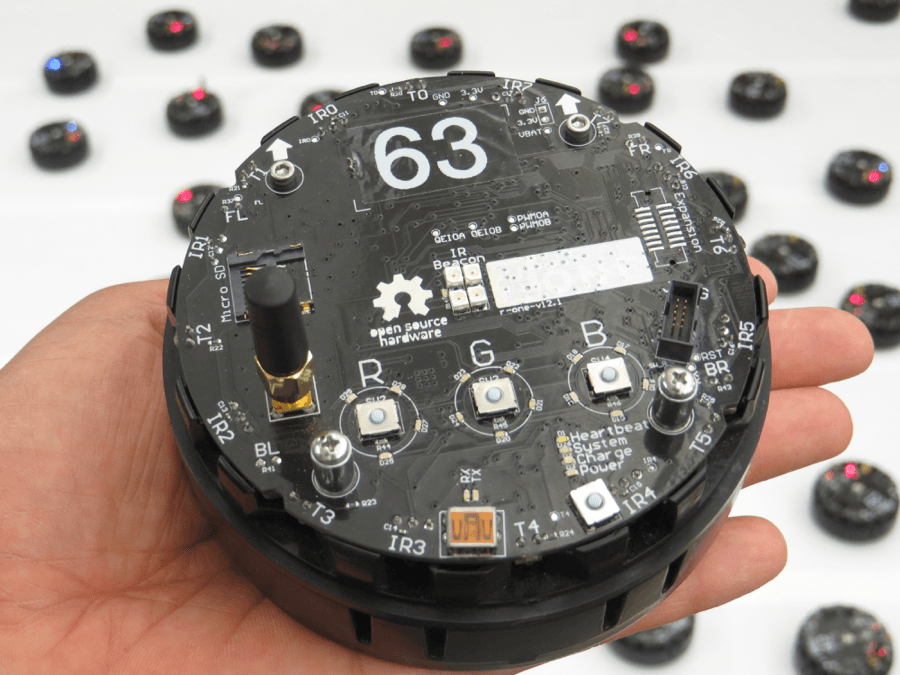Visible Expert Profile℠: How James McLurkin’s Robots Made Him Famous

At Hinge we have been studying Visible Experts℠, people who have attained high visibility and expertise in their industry, creating a personal brand that is recognizable industry-wide. We study them because we want to understand how they attained that status and what we can learn from them. This profile focuses on James McLurkin, a Visible Expert for robotics technology.
James McLurkin’s fascination with engineering and robotics started early, when he would tinker with the toys of his 1980s childhood. “It started with cardboard boxes when I was really little,” James explains. “Then I moved on to Lego bricks, model trains, BMX bikes, remote-controlled cars, and basic video games, like Pac Man.” James would take his toys apart to understand how they worked and improve their designs. “Remember the Doozers, those engineer guys from [the TV show] Fraggle Rock?” he asks. “I was just trying to build myself a Doozer world.”

MIT was a natural next step for a young engineer, where he soon found a place in the lab of the famous roboticist, Rodney Brooks. “Rodney and the other students in the lab had a huge influence on me,” James says. “He was encouraging us to read biology papers, to understand how things in the natural world could be useful in robotics. I became very interested in insects and even raised a pet ant colony. My advisor was working on micro robots, and I ended up building the smallest robots of the time—robot ants. It all just came together.”
Developing a Brand-New Field
In graduate school, James gained attention for winning the prestigious Lemelson–MIT Student Prize, awarded to the world’s top inventors. He won the prize with his 4.5-inch micro robots, modeled from nature, that used bee-like behaviors to perform in a group, or swarm. His invention became the basis for “swarm robotics,” a brand-new field in which he is still one of the reigning experts.
According to James, the ultimate purpose of his work is to create robots that can do things that are impossible for human beings. With swarm robotics, tasks like “finding the disappeared Malaysian airline in the ocean, or exploring Mars, suddenly become possible,” he says. James’ robots are still far from being able to perform these tasks, but new breakthroughs are coming daily.

One of James McLurkin’s r-one robots, designed to perform tasks in swarms.
“I’ve got 160 robots in my lab and I run them around to my heart’s content,” James says. “Currently we’re working on multi-robot recovery, which means getting them all back home without relying on GPS and mapping technology. It’s really tricky. For instance, if one robot goes around a corner, it might lose the other ones. So we gave them an algorithm so that if they come to a corner, one set of robots will stay still, while others go ahead to scout. It gets complicated quickly.”
Using his Visibility to Make Change
Winning the Lemelson prize catapulted James into the national spotlight and, initially, he wasn’t prepared for the attention. “My first reaction was to run and hide. I was losing the battle to preserve my time and do my work,” he says.
Then James began to realize that he could use his visibility as a platform to affect social change. “My goal became: how can I reach next generation? Let’s face it, research papers are read by only a few dozen people in your field. They don’t have an impact on the wider culture. So I realized that having a social mission required engaging with the public, doing media requests. It required me to walk toward the cameras, not away.”
SEE ALSO: The Visible Expert: How Thought Leadership Marketing Can Help Build Your Firm
Creating a Social Agenda
As part of his social agenda, James created a message that would shape his speaking engagements and media appearances. “Very simply, my message is: ‘the democratization of science opportunity.’ In our society, we can’t afford not to have everyone participate. We can’t intellectually disenfranchise a large portion of our population and expect to stay competitive, to be the ones inventing the next new technology.”
Over the past decade, James has taken this message on the road, using high-profile media appearances to spread the word in forums like PBS’s Nova, The History Makers, Time magazine, and the TedYouth conference.
James’ social agenda has also become a gatekeeping mechanism, helping him decide which media engagements to accept. “My first question to myself is always: what is the impact for the next generation of STEM professionals?” Only after passing that hurdle does he look at his availability and speaking fee. James notes, “I’ve turned down well-paying jobs to speak to a more targeted audience of minority students. I feel a responsibility to be a role model and to show kids what is possible.”
“Make it Fun”
As the inspiration for his next venture, James is returning to childhood. “It’s time to start building some new toys,” James says. “I want to build something that the next generation can use to become inspired, based on my own interests as a kid.”
James has been encouraged by the resurgence of science and robotics in popular culture, demonstrated by events like the Maker Faire and the success of commercial electronic kits like the Arduino circuit board. “I want to create something that’s halfway between a toy and a science kit,” he explains. “A kit is not quite fun enough, but a toy is already built and you can’t take it apart and get into it. I want it to be an entry point that will get kids excited about robotics.”
Fun is at the heart of everything James does, and it’s the reason why his message resonates with young people. It’s also a good way to expand visibility in a profession that is stereotypically difficult and dry. James has a remedy for that, as well. “In your work, think about making fun activities for middle-school students,” he advises other STEM professionals. “If you can convince them that your work is interesting, you can convince anyone.”
If James’ story inspires you, download our free ebook below, The Visible Expert, and learn how to become a Visible Expert in your industry.
On Google+ or LinkedIn? Follow us +HingeMarketing and join us on LinkedIn.
Industries & Topics
Most Popular
- Business Development Strategy: A High-Growth Approach
- A 10 Step Brand Development Strategy for Your Professional Services Firm
- Strategic Marketing for Professional Services
- Digital Branding for Professional Services
- 10 Essential B2B Marketing Strategies to Grow Your Professional Services Firm
- Digital Marketing Strategy for Professional Services
- Rebranding Strategies: A Step-By-Step Approach for Professional Services
- Elements of a Successful Brand 1: Brand Positioning
- The Top 5 Business Challenges for Accounting & Financial Services Firms
- Find Your Differentiator: 21 Ways to Gain a Competitive Advantage for Your Firm
- Elements of a Successful Brand 4: Brand Promise
- What Is the Cost of Video Production for the Web?





Leave a Comment